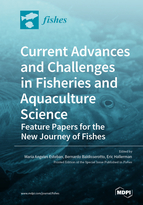Current Advances and Challenges in Fisheries and Aquaculture Science: Feature Papers for the New Journey of Fishes
A special issue of Fishes (ISSN 2410-3888).
Deadline for manuscript submissions: closed (15 December 2021) | Viewed by 35264
Special Issue Editors
Interests: fish immunology; immunostimulation; pollution; diseases; cell biology
Special Issues, Collections and Topics in MDPI journals
Interests: physiology; osmoregulation; anesthesia; antibacterials; culture of tropical freshwater fish
Special Issues, Collections and Topics in MDPI journals
Interests: genetics education; population genetics; aquaculture; biotechnology
Special Issues, Collections and Topics in MDPI journals
Special Issue Information
Dear Colleagues,
This Special Issue is designed to celebrate the new journey (SCIE indexing) of the open-access journal Fishes and is focused on presenting new ideas and advances at the cutting edge of fisheries and aquaculture science.
Advances in fisheries and aquaculture science often follow the introduction of new tools or analytic methods. For example, the introduction of geographic information systems led to advances in conservation planning and in the siting of aquaculture operations. Advances in genetic marker technologies led to whole-genome sequencing and improved detection of performance- or fitness-related loci, in turn leading to advances in marker-assisted breeding and conservation planning. Among the keys to successful modern aquaculture is the adequate management of the biology of cultivated species, the introduction of technological innovations (health, facilities, food, analysis, etc.), including the monitoring of activities and impacts or increased biosecurity, as well as the development of specific foods or the improvement of sustainability and business organization. All these examples are illustrative, but not exhaustive.
We invite manuscripts presenting studies of how advances in these or in many other directions can contribute to understanding and applications in the fields of fisheries and aquaculture science. We will then make a decision based on comments and suggestions from reviewers on the full manuscript for this Special Issue or as a regular paper.
This will be a dynamic Special Issue, and articles will be published as soon as the reviewers and editors are ready to accept them, without waiting for the deadline for the entire Special Issue to arrive.
Prof. Dr. Maria Angeles Esteban
Prof. Dr. Bernardo Baldisserotto
Prof. Dr. Eric Hallerman
Guest Editors
Manuscript Submission Information
Manuscripts should be submitted online at www.mdpi.com by registering and logging in to this website. Once you are registered, click here to go to the submission form. Manuscripts can be submitted until the deadline. All submissions that pass pre-check are peer-reviewed. Accepted papers will be published continuously in the journal (as soon as accepted) and will be listed together on the special issue website. Research articles, review articles as well as short communications are invited. For planned papers, a title and short abstract (about 100 words) can be sent to the Editorial Office for announcement on this website.
Submitted manuscripts should not have been published previously, nor be under consideration for publication elsewhere (except conference proceedings papers). All manuscripts are thoroughly refereed through a single-blind peer-review process. A guide for authors and other relevant information for submission of manuscripts is available on the Instructions for Authors page. Fishes is an international peer-reviewed open access monthly journal published by MDPI.
Please visit the Instructions for Authors page before submitting a manuscript. The Article Processing Charge (APC) for publication in this open access journal is 2600 CHF (Swiss Francs). Submitted papers should be well formatted and use good English. Authors may use MDPI's English editing service prior to publication or during author revisions.








